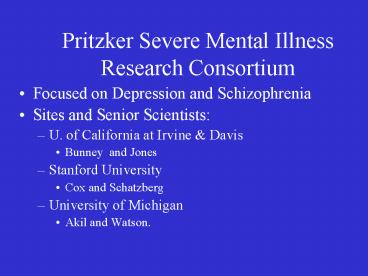Pritzker Severe Mental Illness Research Consortium - PowerPoint PPT Presentation
1 / 22
Title:
Pritzker Severe Mental Illness Research Consortium
Description:
... is a Genetic Machine, of enormous complexity and regulatory capacity--- and it learns!! How Can These Enormous Barriers Be Overcome? A three-way alliance ... – PowerPoint PPT presentation
Number of Views:40
Avg rating:3.0/5.0
Title: Pritzker Severe Mental Illness Research Consortium
1
Pritzker Severe Mental Illness Research Consortium
- Focused on Depression and Schizophrenia
- Sites and Senior Scientists
- U. of California at Irvine Davis
- Bunney and Jones
- Stanford University
- Cox and Schatzberg
- University of Michigan
- Akil and Watson.
2
Questionhow Do We Study Brain Physiology,
Molecular Biology, Drug Development and Illness,
Now?
- Answer A Few Genes at a Time--if You Are Lucky!
3
(No Transcript)
4
What Is the Size of the Brain Problem?
- Many brain regions --hundreds
- Many neuronal circuits--thousands
- Many and multiple neurotransmitters
- Over 100K genes 50 expressed in brain
- Both development and history are critical
So the brain is a Genetic Machine, of enormous
complexity and regulatory capacity--- and it
learns!!
5
How Can These Enormous Barriers Be Overcome?
- A three-way alliance
- Neuroscience
- Molecular biology--human genome project
- High tech optics, electronic, mechanics,
computers and bioinfomatics
6
General Goals of Consortium
- Use modern genetic and neurobiological techniques
to understand the biological basis of depression
and schizophrenia. - Identify genes and brain circuits which play a
key role in the vulnerability to and expression
of depression, schizophrenia and related
illnesses. - Use this information to establish novel
strategies for the treatment and the prevention
of these disorders.
7
Why Use this Approach?
- Complex Genetic Nature of these Disorders.
Searching for a Single Gene has Proven Useless.
Need to Find Patterns of Genes. - Role of Environment and Development not only in
Triggering these Illnesses but in Modifying the
Brain, thereby Increasing the Chance of
Occurrence and Recurrence. - Availability of Neurobiological Information to
Guide Selection of Brain Sites to be Studied.
8
DNA Makes RNA makes Protein
- Two gene copies
- Hundreds to thousands of mRNA copiesThe Key
- Protein is the active agent of the genome
9
How Will We Actually Use These Genomics Tools?
- For mRNA levels by the thousands from a single
tissues sampleMICROARRAYS! Or Other Expression
Systems - For The Study of Genetic Variation High
Through-put Sequencing or Special Gene Arrays
10
Specific Scientific Aims of the Consortium
- To Characterize Altered Profiles of Gene
Expression in Specific Brain Circuits of
Depressed, Schizophrenia and Control Individuals.
- Use Microarrays and other Methods to Study these
Profiles in Postmortem Human Brains. - To Ascertain Possible Differences in Genomic
Structure in Selected Differentially Expressed
Genes via Family Studies. - To Understand the Expression, Distribution and
Function of those Genes which Exhibit Significant
Differences in Structure or Gene Expression.
11
Major Components
- Aim I
- Postmortem Brains
- Microarray and Invader Assay Logic, Strategies,
Techniques - Follow-up on Differentially Expressed Genes
- Aim II
- Family Studies of Candidate Genes
- Aim III
- Rodent Studies
- Primate Studies
12
Flow of Studies and Relationship between Aspects
of the Project Sites Scientists Array Analysis
13
Flow of Studies and Relationship between Aspects
of the Project Sites Scientists Post-array
Analysis
14
Celera!!
15
(No Transcript)
16
Teleconferencing Tools
- All 4 Sites Contacted ( 2 Systems at Stanford
n5) - Phone Conferencing -- Better than Web
- NetMeeting Via Web For Data Sharing- Any
Application For All to See and Edit - One-to-Many
- Video Projector For Many Participants
17
Aim I Post-Mortem Studies
- Postmortem Brains Acquisition and
Characteristics. - Microarray and Invader Assay Logic, Strategies,
and Technical Considerations. - In Situ Hybridization Validation of Differential
Expression of Specific Genes Detected by
Microarray.
18
Brain Status to Date
- Chosen and dissected eight normal brains (4
female and 4 male) for regional anatomical and
array and invader assay calibration (250 blocks). - Matched nine depressed and nine controls.
Dissected and will be studied in the next few
months (1,000 blocks). - Several Schizophrenic and Depressed and Normals
in Process. - Tissue for Transplant Act and the Bunney/Jones
- Brain bank.
19
Donor Referral and Consent Center
- Newly formed regional center that takes all
hospital deaths in Orange, Los Angeles and
various northern counties - Psychiatric screening questions for all reported
deaths initially for Orange County with eventual
expansion into L.A. - Orange County reports 1800 annually
- L.A.County approximately 5000 annually
20
UCI Brain Totals By Year
21
(No Transcript)
22
Thousands of mRNA types in each brain area!!!































